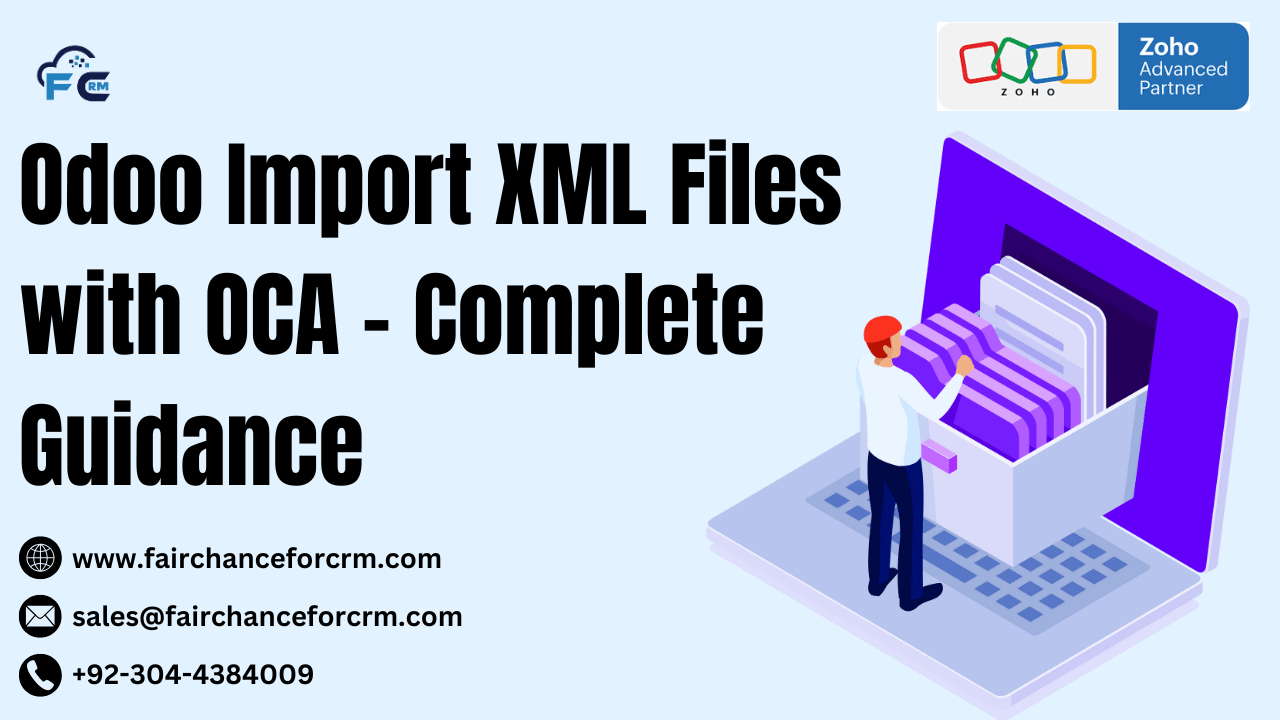Odoo imports XML files using OCA. Many industries use the open-source ERP platform, Odoo, to manage business operations, such as accounting, inventories, and sales. Among the key features of Odoo is the smooth import and export of data. Importing data using XML files is an effective method, especially in working with large datasets, product catalogs, or mass updates. Importance, use cases, and code examples of importing an XML file via modules of OCA (Odoo Community Association).
Also Read:
- AI Autocompleter in Odoo
- Internal Owner Transfer in Odoo
- AI Invoice OCR in Odoo
- Odoo vs Microsoft Dynamics
- Odoo Request Catcher
What is Odoo Import XML Files with OCA (Odoo Community Association)?
The nonprofit Odoo Community Association (OCA) is also contributing to the development of the open-source ecosystem of Odoo. OCA maintains a set of some of the best Odoo modules that enhance the platform’s core functionalities. All these modules are available free of charge under the GNU GPL v3 license and are maintained by the community members and the public.
The use of OCA modules has become a standard methodology in improving the functionality of Odoo in various fields such as sales, inventory control, accounting, human resources, among others. The import of XML files is one of the most commonly applied applications in increasing capabilities to enhance Odoo when adding and populating records from installation or module update activities.
Why Odoo Import XML Files with OCA?
- Standardization: OCA modules follow best practices and ensure that the XML import process adheres to Odoo’s standards, providing consistency across different implementations.
- Efficiency: Importing XML data allows you to automate the process of configuring and setting up data, whether it’s product categories, customer information, or complex business rules.
- Bulk Data Handling: XML is an ideal format for importing bulk data. If you need to import large datasets, OCA’s tools simplify this process while ensuring that the data is correctly structured.
- Scalability: By using XML, you can ensure that data is correctly structured and can scale as your business grows. OCA modules support the import of various types of data, making it adaptable to different business needs.
Common Modules Odoo Import XML Files with OCA
OCA provides several modules that can assist with importing XML files into Odoo, either for configuration, data migration, or other use cases. Some common OCA modules that facilitate XML imports include:
1. base_import:
This module provides a framework to import and export data for various models within Odoo. It supports different file formats, including CSV, Excel, and XML. The module is often used to handle data import tasks in a more user-friendly way.
2. product_import:
Part of the OCA’s sales and inventory suite, this module allows you to import product-related data via XML files. It’s used when migrating product catalogs, updating product information, or transferring bulk inventory data from another system into Odoo.
3. accounting_import:
For accounting-related imports, the accounting_import module helps import accounting data from external systems or XML-based files into Odoo. It can handle invoices, journal entries, and other financial records.
How to Import Odoo Import XML Files with OCA
OCA modules make XML imports easier by providing pre-configured mechanisms and structure. Here’s a guide on how to import XML files using OCA-supported modules:
1. Defining XML Data in Your Module
When creating or customizing a module, the XML data is typically stored in the data folder. For instance, if you’re importing product categories or other related data, you will define these records in an XML file.
Here’s an example of how to import product categories using an XML file in an OCA module:
Example: Import Product Categories with XML
This XML file defines three product categories: Books, Electronics, and Furniture. To ensure the categories are loaded into Odoo when the module is installed or updated, this XML file would be referenced in the module’s __manifest__.py file.
2. Adding XML to Module’s Manifest
Once the XML file is defined, the next step is to ensure it’s included in the module’s installation process. This is done by referencing the XML file in the __manifest__.py file, which tells Odoo to load the data upon installation.
3. XML Import Process in Odoo via OCA Modules
Once the module is installed, Odoo will automatically load the XML data from the defined file. If the XML data contains a <record> tag referencing existing records, Odoo will update those records. If the records don’t exist, Odoo will create them.
4. Bulk Import via OCA Framework
In the case where you want to perform bulk imports (e.g., importing a large number of products, categories, or customers), you can use the OCA’s base_import module. This module provides a user-friendly interface for importing data and supports XML files.
To perform bulk imports via the OCA framework:
- Navigate to the Import option under the relevant model (e.g., Products or Contacts).
- Select XML as the import file format.
- Upload your XML file and follow the prompts to map fields and import the data.
Example of a More Complex Import: Products and Categories
You might want to import products and link them to categories. Here’s how you can do this using XML:
In this example, two products are added under the Books category. The ref attribute is used to link the product to the appropriate category.
FAQs About Odoo Import XML Files with OCA
1. What are the advantages of using XML for imports in OCA?
XML files offer a structured, scalable, and consistent way to import and configure data in Odoo. They can easily handle complex relationships between records, and their use in OCA modules ensures that best practices are followed.
2. How can I ensure the XML import process is smooth?
Ensure that your XML file is properly structured, follows the correct format, and doesn’t contain errors. Also, ensure that all dependencies (e.g., categories, fields, models) are available in Odoo before attempting the import.
3. Can I update existing records with XML?
Yes, you can update existing records by ensuring the correct unique identifiers (IDs) are included in the XML file. If a record with that ID already exists, it will be updated rather than created.
4. Can I perform bulk imports using XML?
Yes, you can use XML files for bulk imports, especially for migrating data from other systems into Odoo or importing large product catalogs.
Conclusion
Odoo Import XML Files with OCA modules in Odoo is an important skill for developers and businesses that want to automate data imports and configurations. The OCA offers a number of modules that make the import process easier, ensure consistency, and allow you to work with large datasets effectively.
Using OCA’s structured and efficient tools, businesses can streamline their Odoo implementations, automate repetitive tasks, and ensure data accuracy. Whether you are importing product information, customer data, or financial records, understanding how to work with XML imports in Odoo can significantly improve your experience with the platform.
For more information about the Odoo Import XML Files with OCA, visit this link.
If you want to Free Trail Zoho, click on this link.




